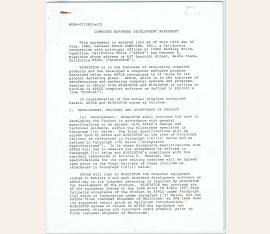Apple-Gründer (1955-2011). Document Signed ("steven jobs") as Chairman of Apple Computer, Inc. & ("K.R. Wigginton"). Cupertino, CA. 4to. 12 pp.
$ 198,209 / 185.000 €
(86238)
"Computer Software Development Agreement," being an agreement between Apple Computer, Inc. and (Kenneth) Randy Wigginton, as a semi-independent developer, for a "MacIntosh Word Processor" and the core editing routines. Randy Wigginton was one of the earliest Apple employees. He was still in High School in 1976 when he began in working with Steve Wozniak on the circuit design and ROM software of the Apple II. He was also one of team members that had adapted Microsoft's 6502 BASIC for the Apple II, which became known as Applesoft BASIC.
Although he had frequently been the target of Steve Jobs' criticism, Jobs recognized that Wigginton was a brilliant programmer and brought him on to the Macintosh team as soon as he had taken it over. Wigginton left Apple in late 1981 to work as an independent programmer, but Jobs convinced him to work on what was to become one of two "killer apps" that shipped with the original Macintosh, MacWrite. "WIGGINTON is in the business of developing computer products and has developed a computer software program described below that APPLE recognizes is of value to its product marketing plans." The present document is the initial contract between Wigginton and Apple Computer, Inc. It outlines the parameters of the agreement including targets, payment, ownership, marketing, technical support and even the loan of hardware (including 2 Macintosh computers, an Apple Lisa, and a ProFile Disk Drive). Apple, essentially Steve Jobs since it was he who signs this contract on behalf of Apple, clearly indicates in the first paragraph, printed above, that MacWrite was essential for the initial rollout of the Macintosh. It was a key component of Jobs' vision of what personal computing could be. The graphical user interface (GUI) and WYSIWIG (what you see is what you get) environment incorporated from ideas borrowed Xerox Parc would help to make word processing "friendly" and enhance the personal computer's role as a tool for personal empowerment. Wigginton soon after formed Encore Systems, one of the first third party developers for the Macintosh, along with Microsoft, and was eventually able to renegotiate this unfavorable deal which places a limit on the per-unit commission that Wigginton could receive. "APPLE will pay to WIGGINTON $2.00 for each MacIntosh computer sold by APPLE during such calendar quarter, except that the payment for the first 50,000 MacIntosh computers will be $1.00. APPLE shall make such payments whether or not the Product was part of a sale ... The total amount of payments to WIGGINTON under this paragraph 2 (b) shall not exceed $950,000." The core editing procedures of MacWrite were a key component of text editing in the Macintosh and for desktop publishing. They allowed elements like fractional character width, leading, full justification—all things necessary to bring a professional layout to personal computing. Apple makes a distinction in the agreement between the word processor and these core editing routines: "WIGGINTON agrees that as of the time that APPLE first distributes copies of the core editing routines as part of a system sold to the public, then the license of the core editing routines hereunder is hereby converted to a transfer of ownership to APPLE of all rights, title and interest in the core editing routines for use on any computer." and "Any rights of APPLE to use the Product (other than the core editing routines) with any other APPLE computer is subject to further good faith negotiations by the parties." The development process of the Macintosh as well as MacWrite was a long, exhausting project with the entire Macintosh team as well as Wigginton and his team getting little sleep—especially in the final days of 1983 before the January 1984 Macintosh launch. Wigginton was under intense pressure: "The word processor was not only to be one of only two truly practical applications immediately available ... but was also meant to stand as an example of how a good program could make use of Mac's interface" (Levy p 173). MacWrite, along with MacPaint, would be bundled and shipped with every Macintosh computer sold. It introduced the average computer user to WYSIWIG word processing. When the Apple LaserWriter was released in 1985, all of the elements were in place for a desktop publishing revolution. Levy. Insanely Great. [New York: 1995]..
